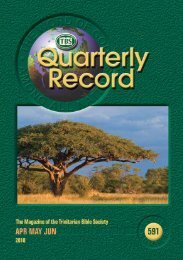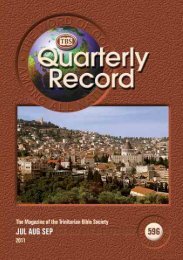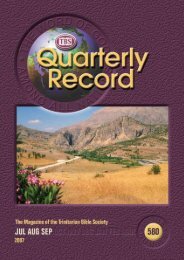QR592.PDF - Trinitarian Bible Society (Australia)
QR592.PDF - Trinitarian Bible Society (Australia)
QR592.PDF - Trinitarian Bible Society (Australia)
- No tags were found...
Create successful ePaper yourself
Turn your PDF publications into a flip-book with our unique Google optimized e-Paper software.
Issue Number: 592 – July to September 2010paragraphs at all in the Bishops’ <strong>Bible</strong>,technically the reference point for the AVtranslators, and it is a well noted curiositythat the AV does not indicate with thestandard the paragraph divisions afterActs 20. This paragraph style of layout is agreat help in avoiding the misperceptionthat one verse equals one sentence, onesense-unit.As tools given into our hands by diligentworkmen seeking only to facilitate serioususe of the <strong>Bible</strong>, chapters and verses servetheir purpose. However, if viewed ashaving some mysterious authority, somelingering glow of inspiration upon them,these servants will become master.Part Two of this article, coming in a lateredition of the Quarterly Record, isplanned to explore the Marking of theText: italics, capitals, and such things.Expect a certain amount of overlap. Theoverall objective is to provide a simpleaccount of how these aspects came to be inthe Authorised Version.Endnotes1. From the Greek words of the Septuagint version,deuteronomion touto (‘this deuteronomy’), the LatinVulgate, along with all modern versions, takes thename of this book. ‘This Deuteronomy’ literallyequates to the requirement of the king.2. Ed.: It should be noted that over the centuriesmany notable Godly scholars (including the PuritanJohn Owen, the Swiss Protestant theologian FrancisTurretin and John Brown of Haddington) havebelieved in, and written extensively on, the divineorigin of the Hebrew vowel points.3. Chapter and verse numbers have no significance,strictly speaking, in the Jewish tradition, but arenoted in modern Hebrew editions so that verses maybe more easily located and cited.4. The Hebrew <strong>Bible</strong> combines 1 and 2 Samuel, 1 and2 Kings, 1 and 2 Chronicles, and Ezra-Nehemiah intojust four books, the twelve Minor Prophets into one.5. This ‘Psalm Numbering’ box is very basic, andcomparisons of Hebrew, Greek, Latin and modernlanguage Psalm-numbering and Psalm-versenumberingcan be daunting.6. These are not to be confused with theexplanatory or interpretative headings inserted inmany <strong>Bible</strong>s today.7. Discussion of the canon of Scripture—the list orrule of inspired books—is no proper part of thisarticle.8. But some have attributed them to Cardinal Hugo,constructed for use in his concordance to the LatinVulgate around 1240, first printed 1479.9. F. H. A. Scrivener, A Plain Introduction to theCriticism of the New Testament, 4th edition (London,England: George Bell & Sons, 1894), p. 68.10. One of the 4th century manuscripts upon whichthe modern Critical Greek Text is based.11. An early system, c. 5th century, for subdividingthe Gospels, used before the advent of chapters andverses.12. A line/word counting system.13. Someone is sure to ask about the EusebianCanons. This was a cross-referencing systemembedded on the page by a scheme of Romannumerals in the margins of the Gospels, by which thereader could find the way from an event recorded inone Gospel to the equivalent or parallel sections (ifany) in the other Gospels.14. The Masorah is the body of marginal notationsfound in editions of the Hebrew Old Testament. Thesenotations were compiled by rabbinic scholars of theearly Christian era and were produced primarily toprotect the text from alteration. Although these arenot inspired, the Hebrew text is consideredincomplete without them.21





![The Love of the Truth [pdf] - Trinitarian Bible Society](https://img.yumpu.com/49788277/1/184x260/the-love-of-the-truth-pdf-trinitarian-bible-society.jpg?quality=85)
![Bible Word List and Reading Plan [pdf] - Trinitarian Bible Society](https://img.yumpu.com/46882563/1/177x260/bible-word-list-and-reading-plan-pdf-trinitarian-bible-society.jpg?quality=85)
![Click to Download Document [pdf] - Trinitarian Bible Society](https://img.yumpu.com/44904205/1/184x260/click-to-download-document-pdf-trinitarian-bible-society.jpg?quality=85)
![Download Document [pdf] - Trinitarian Bible Society](https://img.yumpu.com/44584740/1/184x260/download-document-pdf-trinitarian-bible-society.jpg?quality=85)


![Download Document [pdf] - Trinitarian Bible Society](https://img.yumpu.com/41007786/1/184x260/download-document-pdf-trinitarian-bible-society.jpg?quality=85)
![Click to Download Document [pdf] - Trinitarian Bible Society](https://img.yumpu.com/40894484/1/188x260/click-to-download-document-pdf-trinitarian-bible-society.jpg?quality=85)


![Download Document [pdf] - Trinitarian Bible Society](https://img.yumpu.com/39425868/1/184x260/download-document-pdf-trinitarian-bible-society.jpg?quality=85)
![Download Document [pdf] - Trinitarian Bible Society](https://img.yumpu.com/39425821/1/184x260/download-document-pdf-trinitarian-bible-society.jpg?quality=85)